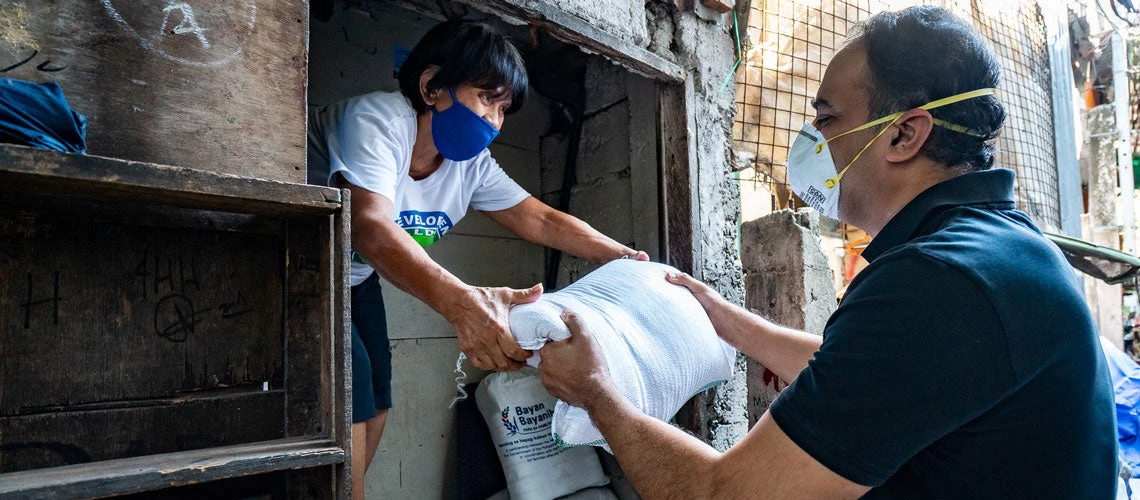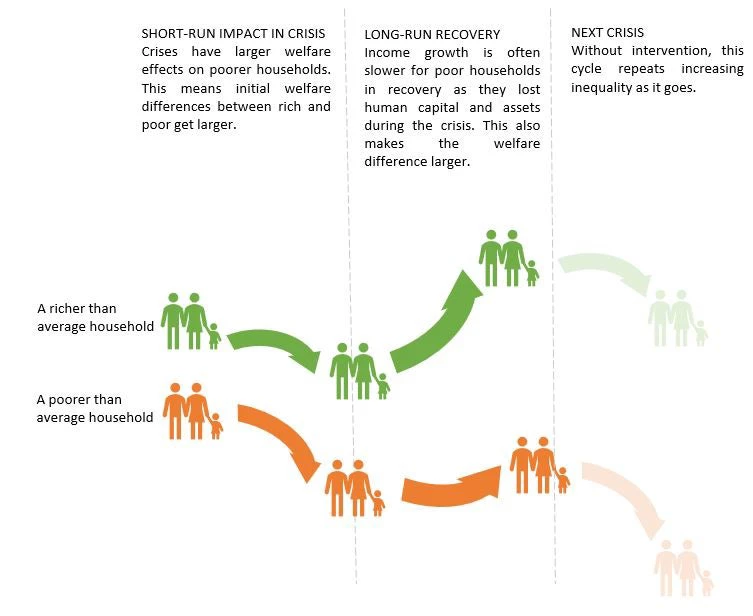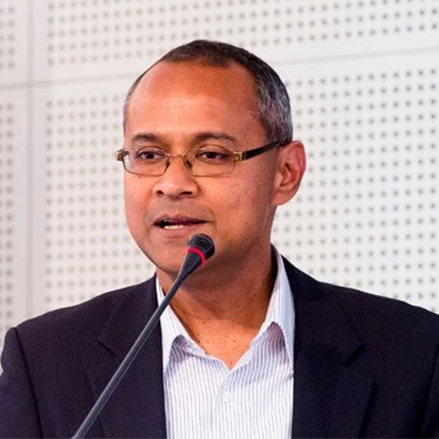 Bayan Bayanihan will provide installments of food to support the most vulnerable households for a period of up to 8 weeks, with an estimated $20 million needed for essential food supplies in this period. © Eric Sales/ Asian Development Bank
Bayan Bayanihan will provide installments of food to support the most vulnerable households for a period of up to 8 weeks, with an estimated $20 million needed for essential food supplies in this period. © Eric Sales/ Asian Development Bank
The COVID-19 pandemic hit amid high inequality and low social mobility in many developing economies and brought these inequalities into sharper focus. The pandemic also poses significant risks to long-term equity and social mobility , as we discuss in a recent paper, using evidence from past crises and early insights from data collected during this pandemic.
What history tells us: Pandemics are not good for inequality
A recent study on the effects of five pandemics between 2003 and 2016 finds that on average, income inequality in affected countries increased steadily over the five years following each event, with the effect being higher when the crisis led to contraction in economic activity, as is the case with COVID-19.
The historical estimates probably understate the potential long-term effects of COVID-19 , given the much larger income impacts of this pandemic. Five years after a pandemic is also too soon for the full impacts on inequality of opportunity and social mobility to emerge. Lower social mobility, or greater persistence of outcomes such as education and income across generations, holds back a society’s progress by perpetuating inequality, reducing economic growth and social cohesion over time.
What early evidence shows: COVID-19 is affecting the poorest the most, increasing inequality
Short-term projections by the World Bank and the International Monetary Fund suggest that extreme poverty worldwide and income inequality for low-income and emerging economies are likely to increase in 2020. Within countries, early data indicate that labor market impacts of the pandemic are strikingly unequal, varying with characteristics of jobs, workers and firms. Data from the COVID-19 dashboard show that in most countries, college-educated workers are less likely to stop working than those with less education and women survey respondents are more likely to stop working than men. The rate of job losses was highest in industry and urban services, which tend to have jobs that are least amenable to working from home. Phone surveys of firms show that micro and small firms, relative to large firms, have a higher probability of falling into arrears. Thus, a temporary loss of revenues for these firms can turn into longer-term erosion of jobs and entrepreneurial capital, which disproportionately affects workers who are young, low-skilled or without access to capital.
Schooling disruptions are also more likely to affect the poorest most. In Ethiopia and Nigeria, for example, the richest 20% of households were much more likely to have children engaging in any learning activity after school closures than the bottom 20%.
What to expect in the future: Three reasons to be concerned about rising long-run inequality
Evidence from previous disasters suggests that not only can welfare impacts on the poorest households be larger, recovery after a shock can also be slower (Figure 1). We currently see three causes for concern that, unless addressed, this pattern will play out for this crisis too.
Figure 1: Inequality and crises: a vicious cycle

- Even though the length of the recession is currently unknown, evidence points to long impacts of job losses. An unemployment spell for a new job market entrant can lead to lower lifetime earnings due to the lost time of (potential) experience, skills depreciation and scarring effects, which can be particularly severe for workers from poorer households and those with lower skills. For similar reasons, higher rate of job losses among women can also have a persistent impact on women’s employment and wages.
- The strategies poor households are using to cope with income losses are costly in the long run. Evidence from previous disasters shows that when disadvantaged groups experience shocks, they are also more likely to adopt coping strategies – such as reducing food consumption and selling productive assets – that lead to lower accumulation of human and physical capital. Nutritional deprivation for children and mothers has damaging long-term consequences. Data from phone surveys in 33 countries show that reducing consumption is the most common coping strategy used by households to manage income losses associated with COVID-19, adopted by around 40% of households on average. This is confirmed by a high degree of food insecurity reported in the surveys – in an average of half of households in the poorest countries, someone skipped at least one meal in the last month because of lack of resources.
- Disruptions to schooling will have long-term effects. In most low-income countries covered by phone surveys, children in fewer than 30% of households completed at least one teacher-provided assignment since schools closed. Early data from high-income countries (such as Belgium and the Netherlands) suggest significant learning losses that increase educational inequality. Simulations by the World Bank suggest that almost 0.6 years of schooling adjusted for quality will be lost globally due to the COVID-19-linked closures , with a large share of the losses occurring among children in more vulnerable families. Learning losses can have irreversible long-term costs for individuals and society alike. Evidence from past disasters suggests that disrupted schooling and the trauma of shocks can adversely affect learning and produce differences that are observable years later. One study shows that those between age 14 and 17 years during the 1916 polio pandemic in the United States had lower educational attainment compared to slightly older peers who had already completed schooling. Also, as vulnerable households in developing countries suffer income losses, and particularly after a school closure, some may also be less likely to send children back to school.
Policy making with an equity lens is key to mitigate rise in inequality
A strong focus on addressing inequalities is needed. Any mitigation of short-term inequalities in impact reduces the burden on policies to close longer-term gaps created by past inequities . In the medium to long-term recovery phase, the overarching goal of policies would be to foster a durable and inclusive recovery, while building resilience among the vulnerable against future crisis, for which the following policy areas are likely to be critical:
- Boosting investments in health and education, particularly at an early age and for children. This would include interventions to help children and parents in transitioning back to school – preventing dropouts and providing learning support to those who have fallen behind.
- Leveling the playing field in the labor market. The re-entry of the unemployed into jobs, including that of women and youth, can be facilitated by active labor market policies and training , and by improving access to affordable childcare and improving parental leave policies.
- Enhancing access to financial services and technology. Promoting low-cost financial products, improving financial information and enhancing access to digital infrastructure and technology would help micro and small firms, which are critical for bringing back jobs for vulnerable workers, to stay in business and become more competitive.
- Investing in safety nets and social insurance. Rapid support to households to protect against the loss of human and physical assets during a crisis requires investing upfront in the key building blocks that allow safety nets to scale when needed – such as social registries and mobile payment systems – and constantly assessing the risks a country faces.
The time when economies are being rebuilt is the time to prioritize inclusion, equity, and building resilience to future disasters. The pandemic has also underscored that fiscal policymaking must include planning for how spending can increase in the event of a crisis to help households manage the impacts. However, an efficient and cost-effective way of making our societies resilient to future crisis is by taking on structural inequalities today – narrowing gaps in endowments and capabilities between the haves and have-nots of society.
RELATED
The World Bank Group and COVID-19 (coronavirus)
Working Paper: COVID-19 and Inequality: A Review of the Evidence on Likely Impact and Policy Options



Join the Conversation